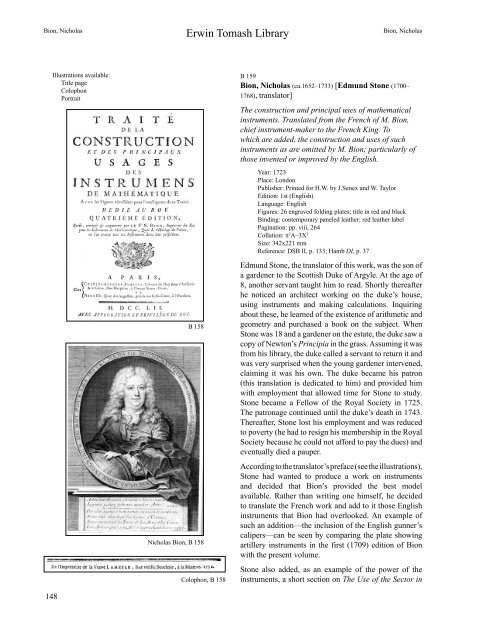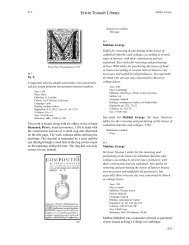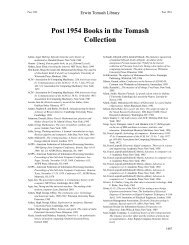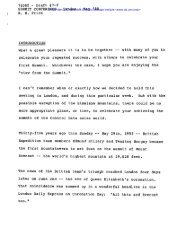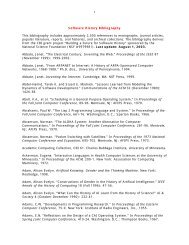B chapter.indd - Charles Babbage Institute - University of Minnesota
B chapter.indd - Charles Babbage Institute - University of Minnesota
B chapter.indd - Charles Babbage Institute - University of Minnesota
You also want an ePaper? Increase the reach of your titles
YUMPU automatically turns print PDFs into web optimized ePapers that Google loves.
148<br />
Illustrations available:<br />
Title page<br />
Colophon<br />
Portrait<br />
Erwin Tomash Library<br />
Bion, Nicholas Bion, Nicholas<br />
B 158<br />
Nicholas Bion, B 158<br />
Colophon, B 158<br />
B 159<br />
Bion, Nicholas (ca.1652–1733) [Edmund Stone (1700–<br />
1768), translator]<br />
The construction and principal uses <strong>of</strong> mathematical<br />
instruments. Translated from the French <strong>of</strong> M. Bion,<br />
chief instrument-maker to the French King. To<br />
which are added, the construction and uses <strong>of</strong> such<br />
instruments as are omitted by M. Bion; particularly <strong>of</strong><br />
those invented or improved by the English.<br />
Year: 1723<br />
Place: London<br />
Publisher: Printed for H.W. by J.Senex and W. Taylor<br />
Edition: 1st (English)<br />
Language: English<br />
Figures: 26 engraved folding plates; title in red and black<br />
Binding: contemporary paneled leather; red leather label<br />
Pagination: pp. viii, 264<br />
Collation: π 2 A–3X 2<br />
Size: 342x221 mm<br />
Reference: DSB II, p. 133; Hamb DI, p. 37<br />
Edmund Stone, the translator <strong>of</strong> this work, was the son <strong>of</strong><br />
a gardener to the Scottish Duke <strong>of</strong> Argyle. At the age <strong>of</strong><br />
8, another servant taught him to read. Shortly thereafter<br />
he noticed an architect working on the duke’s house,<br />
using instruments and making calculations. Inquiring<br />
about these, he learned <strong>of</strong> the existence <strong>of</strong> arithmetic and<br />
geometry and purchased a book on the subject. When<br />
Stone was 18 and a gardener on the estate, the duke saw a<br />
copy <strong>of</strong> Newton’s Principia in the grass. Assuming it was<br />
from his library, the duke called a servant to return it and<br />
was very surprised when the young gardener intervened,<br />
claiming it was his own. The duke became his patron<br />
(this translation is dedicated to him) and provided him<br />
with employment that allowed time for Stone to study.<br />
Stone became a Fellow <strong>of</strong> the Royal Society in 1725.<br />
The patronage continued until the duke’s death in 1743.<br />
Thereafter, Stone lost his employment and was reduced<br />
to poverty (he had to resign his membership in the Royal<br />
Society because he could not afford to pay the dues) and<br />
eventually died a pauper.<br />
According to the translator’s preface (see the illustrations),<br />
Stone had wanted to produce a work on instruments<br />
and decided that Bion’s provided the best model<br />
available. Rather than writing one himself, he decided<br />
to translate the French work and add to it those English<br />
instruments that Bion had overlooked. An example <strong>of</strong><br />
such an addition—the inclusion <strong>of</strong> the English gunner’s<br />
calipers—can be seen by comparing the plate showing<br />
artillery instruments in the first (1709) edition <strong>of</strong> Bion<br />
with the present volume.<br />
Stone also added, as an example <strong>of</strong> the power <strong>of</strong> the<br />
instruments, a short section on The Use <strong>of</strong> the Sector in


